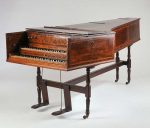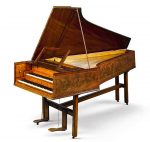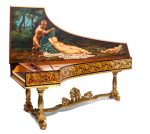Harpsichords. The harpsichord was most likely invented in the late Middle Ages. By the 16th century, harpsichord makers in Italy were making lightweight instruments with low string tension. A different approach was taken in the Southern Netherlands starting in the late 16th century, notably by the Ruckers family. Their harpsichords used a heavier construction and produced a more powerful and distinctive tone. They included the first harpsichords with two keyboards, used for transposition.
The Flemish instruments served as the model for 18th-century harpsichord construction in other nations. In France, the double keyboards were adapted to control different choirs of strings, making a more musically flexible instrument. Instruments from the peak of the French tradition, by makers such as the Blanchet family and Pascal Taskin, are among the most widely admired of all harpsichords, and are frequently used as models for the construction of modern instruments. In England, the Kirkman and Shudi firms produced sophisticated harpsichords of great power and sonority. German builders extended the sound repertoire of the instrument by adding sixteen foot and two foot choirs; these instruments have recently served as models for modern builders.
The harpsichord was widely used in Renaissance and Baroque music. During the late 18th century, with the rise of the piano, it gradually disappeared from the musical scene. In the 20th century, it made a resurgence, being used in historically informed performances of older music, in new compositions, and in certain styles of popular music. Reference: Wikipedia
A harpsichord by John Rooks, Ticknall, thirty keys, turned underframe, 186.5cm long, 75cm wide, dated 1975
Sold for £800 at Bamfords Auctioneers & Valuers in 2019
Harpsichord,late 17th century Italian This harpsichord has three sets of unison strings, one of which is plucked at a point very close to the nut, producing a brighter timbre than the others. The mermaid holding one of the supporting columns is a device of the Colonna family. The painting inside the lid is a landscape that includes a hunter and his dog. On the lid above the keywell is a scene depicting Tobias and the angel Raphael. The conventionalized foliage and the aerial perspective are associated with the work of Gaspard Dughet, brother-in-law of Nicolas Poussin, who painted chiefly in Rome.
Reference: The Metropolitan Museum of Art
Harpsicord by Jacob Kirckman Made in London, Greater London, England, United Kingdom, Europe, 1763. The Kirckman Harpsichord reflects the English tradition of harpsichord making which was characterised by undecorated timber cabinet work of the highest quality. This differed to the Flemish, French and Italian schools that used extensive lid and casework painting. Kirckman was one of the two most prominent harpsichord makers in London during the mid to late Eighteenth century, the other being Shudi and Broadwood. He had a reputation for experimenting in the design of a variety of devices to produce tonal differences. For example this instrument features a foot operated stop lever that can change the combination of registers played and override the manually operated stops.
Reference: Museum of Applied Art and Sciences
A George III Mahogany, Satinwood and Kingwood Double Manual Harpsichord by Jacob (1710-1792) and Abraham (1737-1794) Kirckman, London, 1789 with music desk on trestle stand, the nameboard signed Jacobus et Abraham Kirckman Londini Fecerunt 1789 height 36 1/2 in., width 39 1/2 in., length 84 1/2 in. 93 cm, 100.5 cm, 240 cm
Soundboard with inset rose pierced and carved with King David playing the harp flanked by the maker’s initials I.K., the five octave keyboard, FF to f3, five brass hand stops controlling an 8 ft. and 8 ft. lute stops on the upper manual and two 8 ft., 8 ft. buff and one 4 ft. stops on the lower manual, two pedals, the first controlling the machine stop, the second now controlling the buff stop and formerly with the nag’s head swell (now disconnected), with music desk.
Sold for 37,500 USD at Sotheby’s in 2018
This harpsichord was built by Giovanni Baffo, the leading maker of harpsichords in Venice, one of the main instrument-producing centres in Europe during the 16th century. The instrument is decorated with traditional Islamic patterns, then widely used in Venice, and also fashionable classical motifs, such as Apollo and the Muses, a suitable theme for musical instruments. This instrument has undergone a number of changes, including the altering of the range of the notes, a sign that even if musical fashions changed during the next century the prestige of Baffo’s instruments remained intact.
Harpsichord with one set of keys consisting of 50 notes, ranging from GG/BB to c3, with two sets of strings tuned at the same pitch. The soundboard is made of plain cypress wood, with a rosette made up of elaborate gothic tracery in parchment, built round six lobes enclosing a hexagon with concave sides. The instrument is abruptly truncated at the end.
The edges of the instrument, jack rail and base of the keyboard are decorated with ivory studs. These parts, together with the nameboard and inner sides above the sound board, are veneered with rosewood, decorated with gilt moresques and inlaid with interlinking rhomboid patterns made up of ivory and boxwood. On two such rhomboids at either end of the name board the maker has signed and dated this harpsichord.
The instrument is placed in a case decorated on the outside with scrolls along the bent and straight sides and a garland of roses on the outside of the lid, which was probably added about two hundred years after the instrument was made. The inside of the lid is elaborately decorated with grotesque ornament and consists of two parts, linked with staple hinges: the smaller part covers the keys and jackrail and the larger one the soundboard . The former consists of a circular batswing frame in the centre enclosing two winged putti holding up the three-crescent emblem of the Strozzi family. This frame is flanked by two moulded rectangular ones, each containing a prancing winged putto. All three frames are linked with bandwork, and the spaces in between are filled with masks and scrolls. A batswing lunette is placed at each end. The main part of the lid is dominated with a cartouche containing Apollo and the Muses. Either side are winged putti, masks, batswings lunettes and sphynxes and other grottesques. The decoration is crudely cut off at the end.
Reference: © Victoria and Albert Museum
A Baroque style faux tortoise and parcel gilt paint decorated harpsichord incorporating antique and later elements height 33in (84cm); length 97in (244cm)
Sold for US$ 7,500 (£ 5,974) inc. premium at Bonhams in 2016







